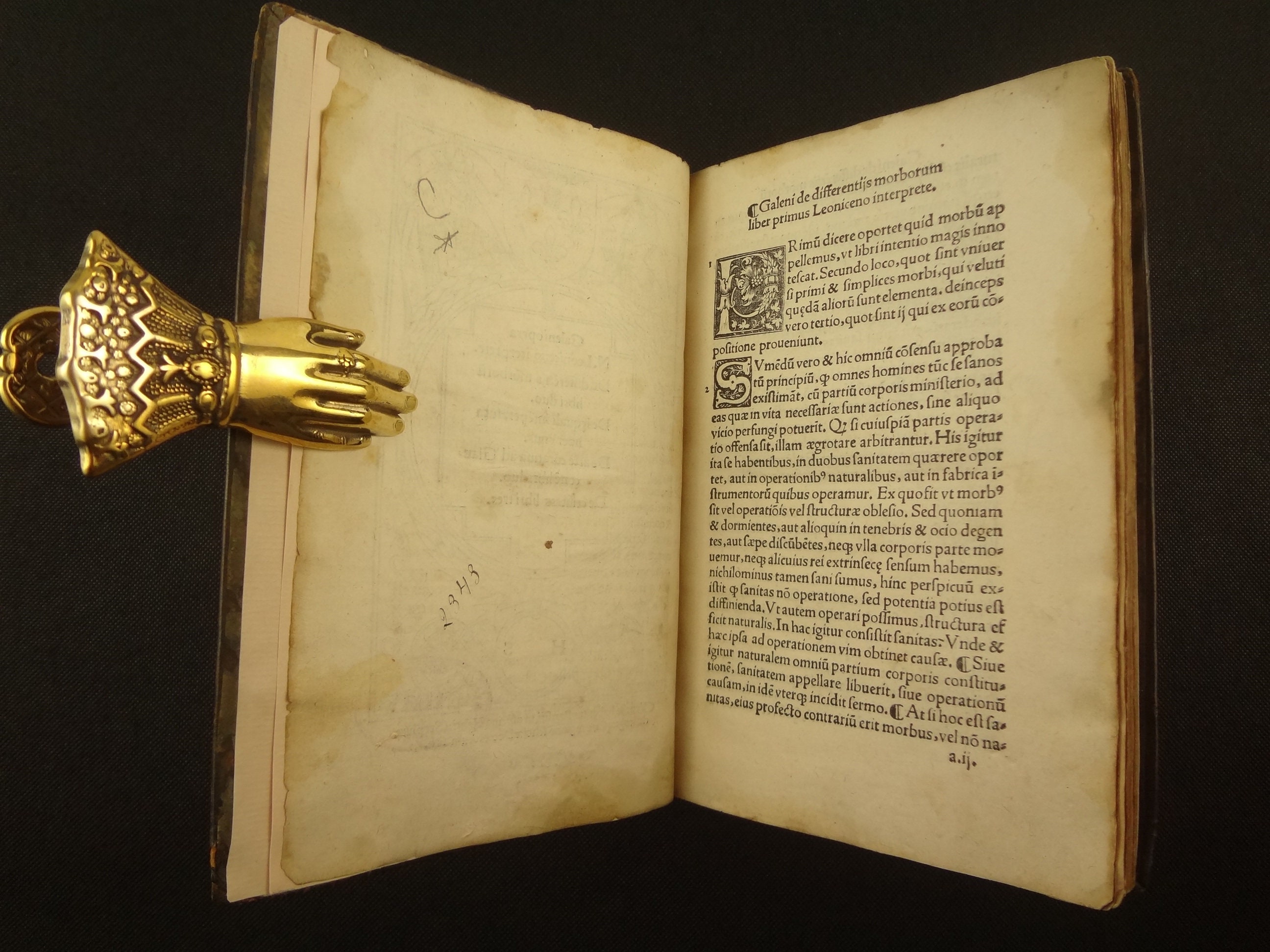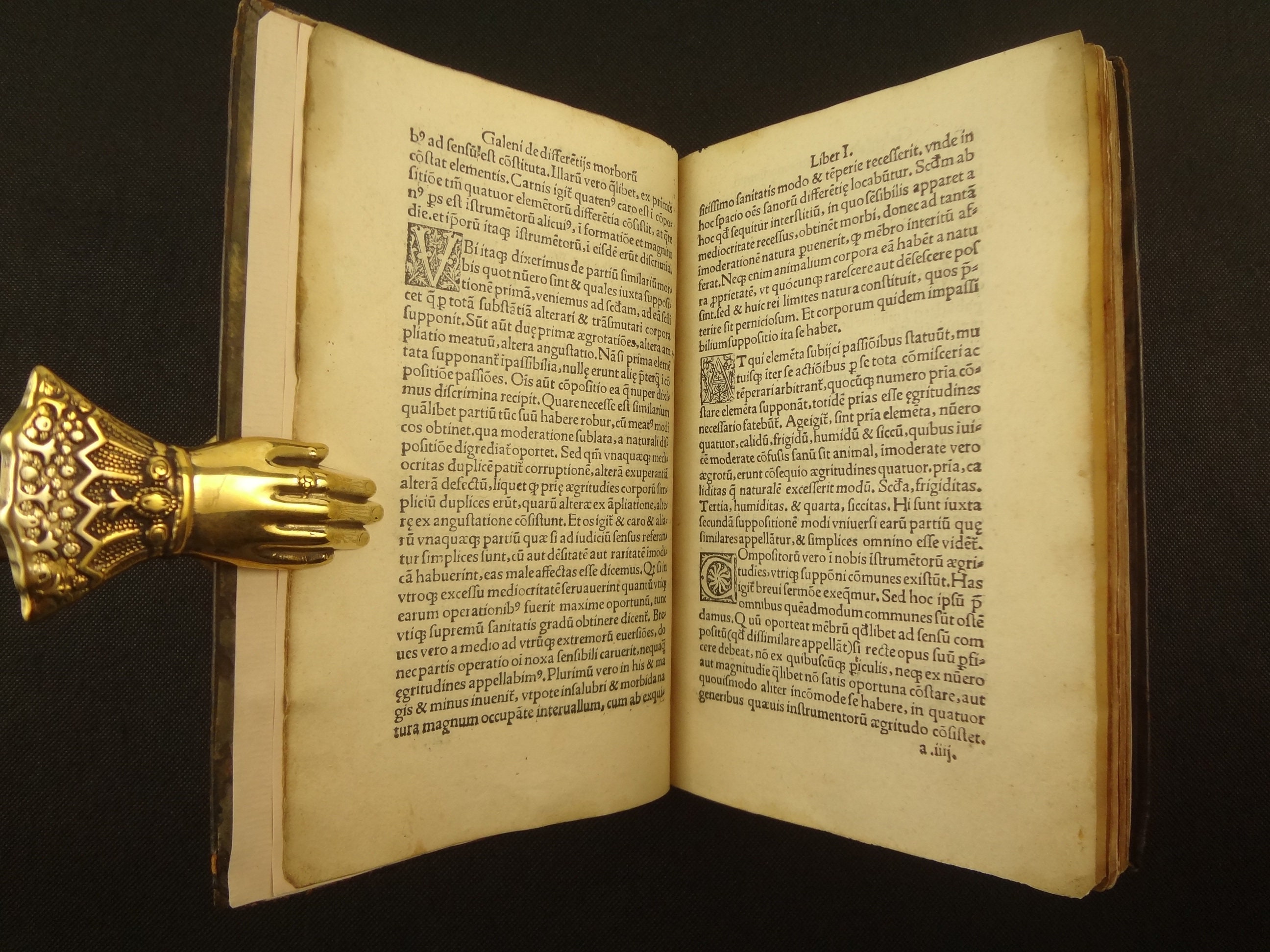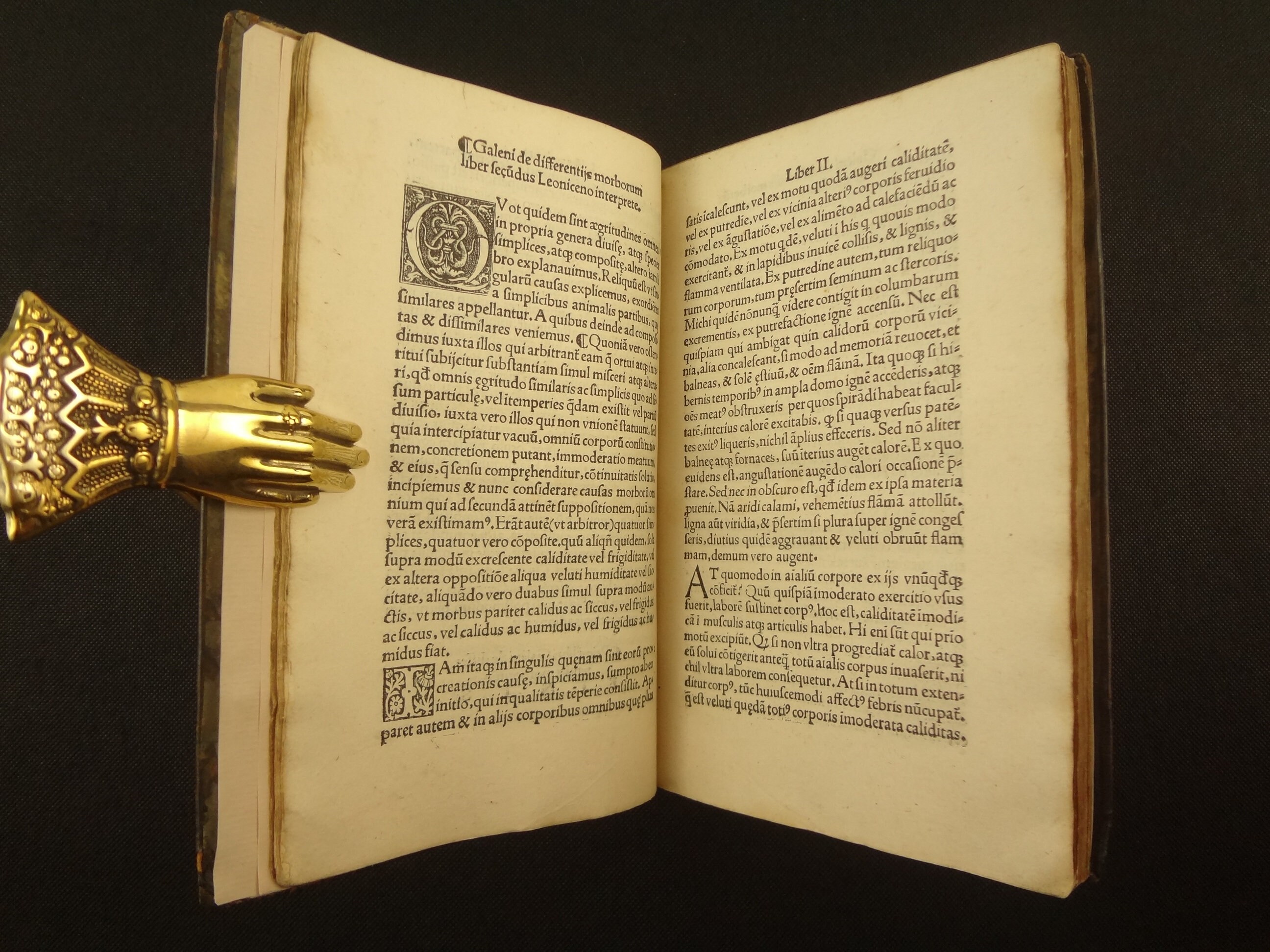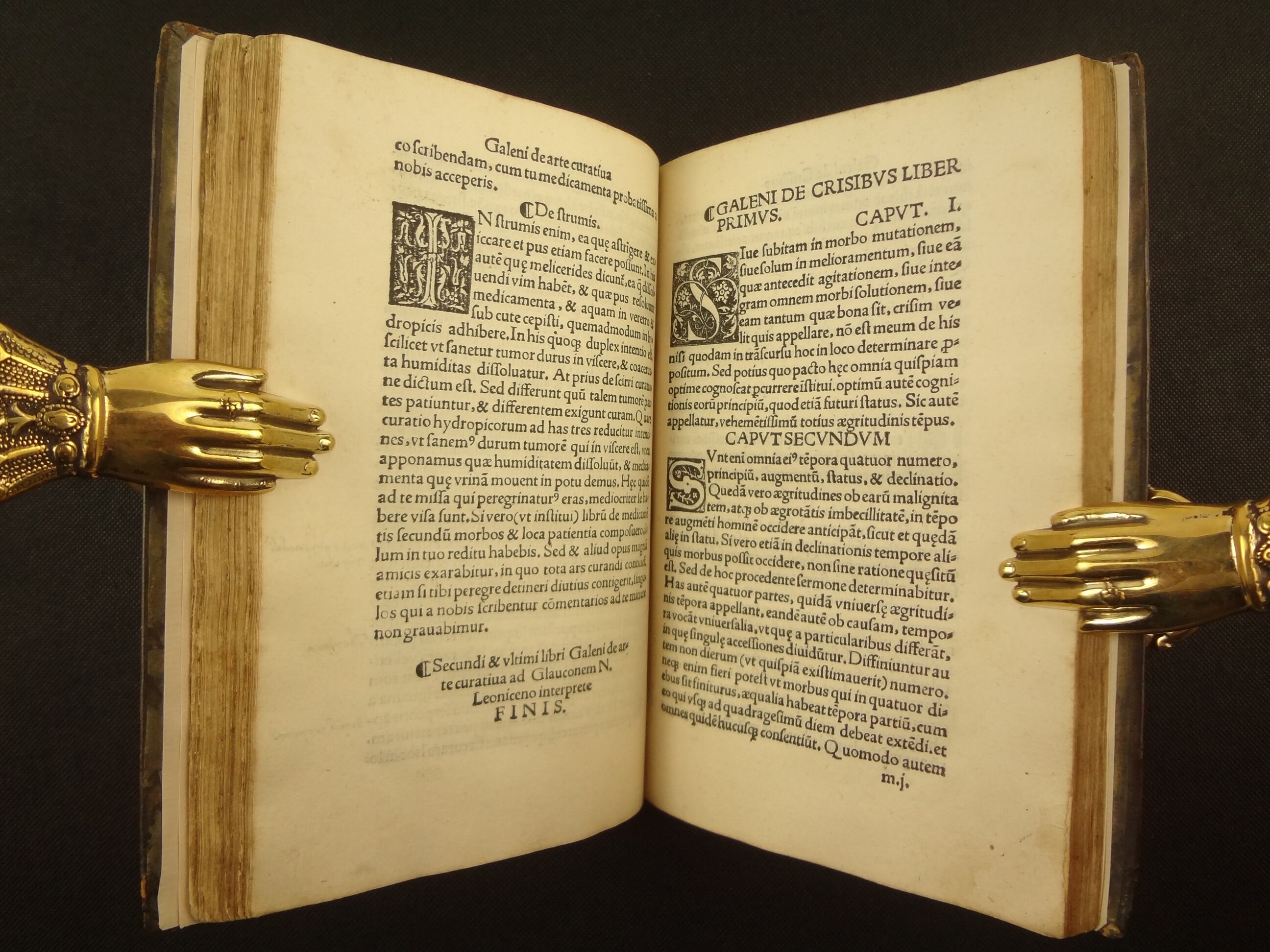1514 Galeni Opera, N. Leoniceno Iterpret. Galen. Post-incunable. Estienne, Paris. Medical. Provenance.
Post-incunable 1514 Henri Estienne first printing (per Goodrich) of Leonicino's interpretations of four books of Galen, with the contemporary boards retained (decorated with Fortune riding a dolphin), contemporary annotational notes filling the margins of De Arte Curativa and a rich history of medical doctoral provenance.
About Galen -
Galen's understanding of anatomy and medicine was principally influenced by the then-current theory of the four humors: black bile, yellow bile, blood, and phlegm, as first advanced by the author of On the Nature of Man in the Hippocratic corpus. Galen's views dominated and influenced Western medical science for more than 1,300 years. His anatomical reports were based mainly on the dissection of Barbary apes. However, when he discovered that their facial expressions were too much like those of humans, he switched to other animals, such as pigs. The reason for using animals to discover the human body was due to the fact that dissections and vivisections on humans were strictly prohibited at the time. Galen would encourage his students to go look at dead gladiators or bodies that washed up in order to get better acquainted with the human body. His anatomical reports remained uncontested until 1543, when printed descriptions and illustrations of human dissections were published in the seminal work De humani corporis fabrica by Andreas Vesalius, where Galen's physiological theory was accommodated to these new observations.
About Leoniceno -
Niccolò Leoniceno (1428–1524) was an Italian physician and humanist. He was a pioneer in the translation of ancient Greek and Arabic medical texts by such authors as Galen and Hippocrates into Latin. Leoniceno began his career in what has been referred to as the age of the manuscript. At this point in time knowledge was acquired primarily through the examination of existing texts. Leoniceno’s library was most impressive, and its contents reflected the textual approach to scholarship popular at the time. An inventory taken after his death revealed 345 volumes comprising 482 individual works.
About the Printer -
Henri Estienne's first work was a Latin translation of Aristotle's Ethics in 1503 or 1504. Estienne's works were primarily theological or scientific. He printed the Abrégé de l'Arithmétique of Boethius in 1503. The Estienne printing studio was established on rue de l'ecole de Droit, where Estienne was printer-bookseller for the University of Paris. Estienne's printmark was of the old arms of the University, a shield charged with three Fleurs de Lis, with a hand emerging from a cloud and holding a closed book with the motto was: Plus olei quam vini ("more oil than wine,"). Estienne took great care to avoid printing errors in his work. If any mistake occurred, he would use errata sheets to correct the error and may have been the first printer to do so.
About the Binding -
Respined, but retaining 16th century boards. Several clues speak to the boards being 16th century:
1. There are the stubs of ties at all edges (two at fore-edge, one at the top and bottom); ties spilled over into the 16th century from earlier vellum books where ties, or clasps, were needed to keep the vellum flat to prevent cockling (curving) of the vellum.
2. The image of Fortune riding a dolphin was a popular early 16th century motif. Examples found online include the medals of Pier Paolo Galeotti and Tomas Bakocz, binding C64b6 in the British Library (also on a work published in 1514), the statue Figure of Fortuna by Giovanni della Robbia (Florence, 1500-1510) and Andreas Summer's engraving Fortuna Standing on a Dolphin.
Provenance -
1833 signature of a "Dr.". Stamps of Maryland Medical society, and a Washington D.C. Surgeon library. Advertisement from James Tait Goodrich, doctor and antiquarian bookseller ($1995).
Rarity -
There are a handful of copies in Europe's libraries, but I find only two in the U.S., one at the University of Chicago (R126.G20 1514) and one at the National Library of Medicine in MD (OCLC 14312052). This is listed in Durling's Medical Library catalogue as number 1768.
Physical Attributes -
Measures approx. 21.5 x 15 x 2, 8vo. Contemporary boards, rebacked. Crushed calf with double-fillet gilt frame, corner leaf tools, and a central Fortuna riding a dolphin in gilt (stubs of expired ties around edges). Four raised bands to spine, ruled in gilt; title in gilt on red morocco in one compartment, author (in another compartment) and date (at foot of spine) also in gilt. Renewed endpapers. Title page with historiated (presumably Galen teaching) woodcut border and printer's mark of Estienne.
Collation - a8, b8, c4, d6, e6 (but mistakenly signed "a"), f-k8, l4, m-s8, t5 (missing blank t6)
Condition -
See pictures. Older binding re-spined; edges and corners worn, some rubbing to board. Stubs of ties at all edges of boards. Endpapers refreshed. Title page well-soiled, with four library stamps ("annoying institutional stamps" - James Tait Goodrich), and several hand-written ex libris and date notes. Some thumbing, fox spots, dog earing, etc. throughout. Contemporary marginal notes throughout De Arte Curativa.... A little damp-staining at edges at front leaves, not present by gathering b. "C*" and "2343" on back of title page. Ink stains bottom margin leaves signed oiii, oiiii. Dampstain at bottom edge at rear. t5 has library stamp. Missing last leaf, signed t6, which Durling notes as "blank".
Shipping from United States
Processing time
1-3 business days
Customs and import taxes
Buyers are responsible for any customs and import taxes that may apply. I'm not responsible for delays due to customs.
Payment Options
Returns & Exchanges
I gladly accept returns
Just contact me within: 7 days of delivery
Ship items back to me within: 14 days of delivery
I don't accept exchanges or cancellations
But please contact me if you have any problems with your order.
Conditions of return
Buyers are responsible for return shipping costs. If the item is not returned in its original condition, the buyer is responsible for any loss in value.
Privacy policy
We do not collect any private information. For billing, Etsy provides the service. We only receive notice that payment was made. The shipping address is provided to us by Etsy, based on what they buyer submitted during check-out. We do not store these addresses. That is the extent of the information that we receive during a transaction.









